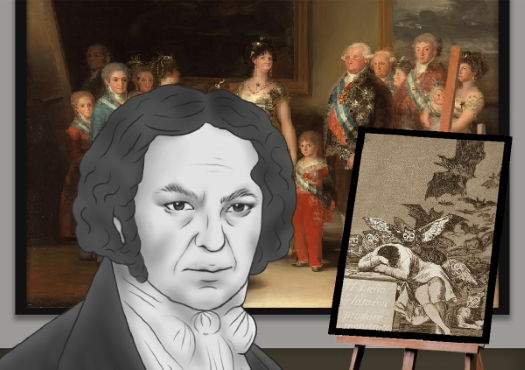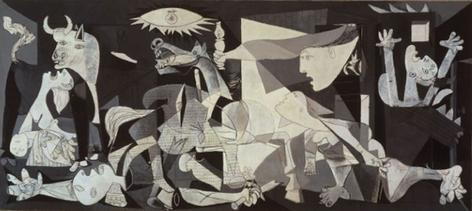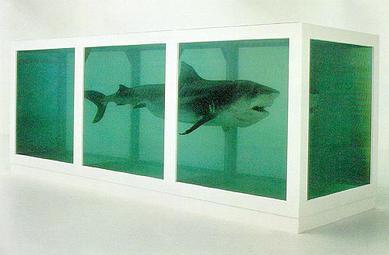Summary of Francisco Goya
Goya occupies a unique position within the history of Western art, and is often cited as both an Old Master and the first truly modern artist. His art embodies Romanticism's emphasis on subjectivity, imagination, and emotion, characteristics reflected most notably in his prints and later private paintings. At the same time, Goya was an astute observer of the world around him, and his art responded directly to the tumultuous events of his day, from the liberations of the Enlightenment, to the suppressions of the Inquisition, to the horrors of war following the Napoleonic invasion. Both for its inventiveness and its political engagement, Goya's art had an enormous impact on later modern artists. His unflinching scenes from the Peninsular War presaged the works of Pablo Picasso in the 20th century, while his exploration of bizarre and dreamlike subjects in the Caprichos laid the foundation for Surrealists like Salvador Dalí. Goya's influence extends to the 21st century, as contemporary artists have also drawn inspiration from the artist's grotesque imagery and searing social commentary.
Accomplishments
- Goya's formal portraits of the Spanish Court are painted in a lavish virtuoso style, and highlight the wealth and power of the royal household. On the other hand, the works have been seen to contain veiled, even sly, criticisms of the ineffectual rulers and their circle.
- Goya is one of the greatest printmakers of all time, and is famous for his achievements in etching and aquatint. He created four major print portfolios during his career: the Caprichos, Proverbios, Tauromaquia, and The Disasters of War. Perhaps even more than his paintings, these works reflect the artist's originality and his true opinions about the social and political events of his day. The subject matter of his etchings veers from dreamlike to grotesque, documentary to imaginary, and humorous to harshly satirical.
- Women occupy a central place within Goya's oeuvre, and his images of majas (the stylish and outlandish members of Spain's lower classes in the 18th and 19th centuries), witches, and queens are some of his most daring and modern interpretations, depicting women in possession of their own powers, whether political or sexual. Many of these works have led to speculation about Goya's private life, for example his supposed affair with the Duchess of Alba.
- Goya's late paintings are among the darkest and most mysterious of his creations. His series of 14 paintings from his farmhouse on the outskirts of Madrid (the so-called "Black Paintings") contain images of violence, despair, evil, and longing. They are the pessimistic expressions of an aging, deaf artist who was disillusioned with society and struggling with his own sanity. Their exploration of the dark forces at work in his own subconscious foreshadows the art of the Expressionists and Surrealists in the 20th century.
The Life of Francisco Goya
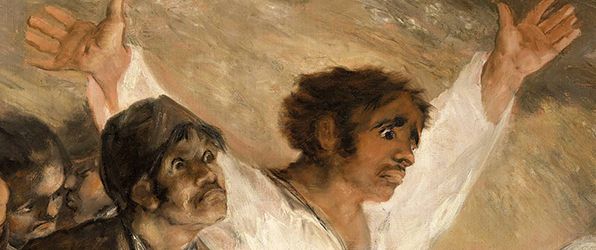
To pass safely through the Spanish countryside occupied by the invading French army, Goya coated his works with a layer of whitewash, so that his depictions of the war’s atrocities could escape detection and be revealed later, as he believed, that art "is about one heart telling another heart where he found salvation."
Important Art by Francisco Goya
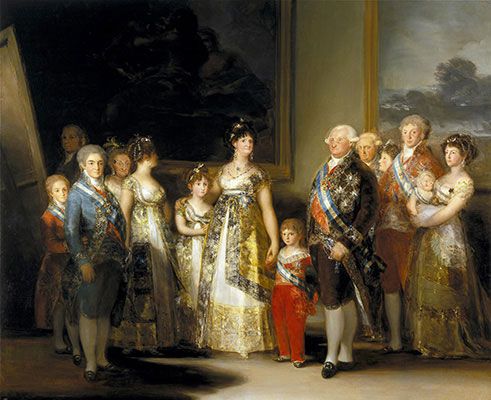
Charles IV of Spain and His Family
This portrait of the Spanish royal family was made at the height of Goya's career as a court painter. Unlike many of his earlier society and court portraits, which hewed more closely to the genre's conventions of flattery, this painting signals a new direction for the artist in its unflinchingly (some might say grotesquely) realistic depictions of its sitters. The artist based the composition on Velázquez's Las Meninas, which also includes a self-portrait of the artist in the act of painting the royal family. Here, Goya depicts himself in the shadows, standing in front of a large canvas (presumably the same one we now behold) in the far left background.
At the center of the composition, brilliantly lit, is the figure of Queen Maria Luisa, who holds the hand of her son Francisco (in vivid red) and her daughter, Maria Isabel. King Charles stands to her left: widely thought to be an ineffectual leader, his off-center placement provides a clue about the power dynamic of the family as well as their foibles and failings. Indeed, the Queen was believed to hold the real power, along with Prime Minister Manuel Godoy, with whom she had an affair (her illegitimate children are at the far left of the canvas, one in blue, the other in orange). Goya's subversive critique - disguised as a glorifying portrait - of the corruption of Charles IV's reign is further enhanced by the subject of a painting hanging in the background, which shows the Biblical story of the immoral and incestuous Lot and his daughters.
From a technical standpoint, the painting dazzles with detail, especially in the luxurious garments and jewels worn by the family. Goya's brushwork is loose and spontaneous in other areas of the composition. Rembrandt's influence on the artist is apparent in this work, notably in the play of light and shadow and in the overall warm tonality of Goya's palette.
Oil on canvas - Museo del Prado, Madrid
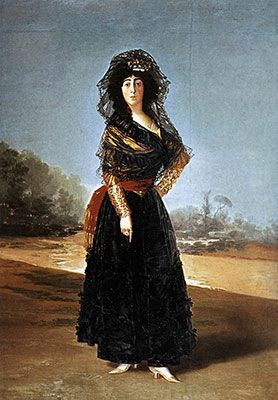
The Black Duchess
Goya was himself the subject of scandal and rumor particularly when it came to his relationships with members of Spain's social elite. For instance, he was suspected of conducting a love affair with the aristocratic Maria Cayetana de Silva, the 13th Duchess of Alba, one of the most famous women in Spain. Their liaison probably began after the death of the Duke of Alba in 1796 (Goya had painted portraits of both husband and wife in 1795). Goya was no doubt taken with the Duchess's haughty beauty, with her curvaceous figure, alabaster complexion, and voluminous black curls.
Painted the year after the Duke's death, this portrait of the Duchess depicts her in mourning black, wearing the traditional costume of a maja, one of the very stylish members of Spain's lower classes known for their bold behavior. In posing as a maja, the Duchess was making an attempt to connect with the masses, despite her elevated social standing. Standing with one hand on her hip, she points toward the ground with her other hand, where Goya has lightly drawn his name in the dun-colored sand. When the painting was restored, the word "solo" was uncovered next to Goya's name, implying that the artist was her only love (though she wears two rings on her hand, one inscribed "Alba", the other "Goya").
Though the painting was commissioned by the Duchess, Goya kept it in his possession for 15 years, indicating his strong attachment to the work and its subject, or, possibly, the Duchess' inability to accept a work that so openly flaunted an affair. Much of the imagery that would populate Goya's prints and drawings following the end of their affair - women as fickle temptresses, men as cuckolded fools, lovers tortured by uncontrollable passions - has lead art historians to suspect that his heart had been broken by the Duchess.
Oil on panel - New York Hispanic Society
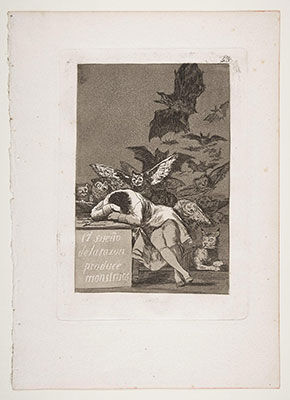
The Sleep of Reason Produces Monsters
Goya is as famous for his prints as he is for his paintings, and is known as one of the great masters of the etching and aquatint techniques. The first of his four major print series was Los Caprichos, which consists of 80 numbered and titled plates. The artist's stated purpose in making the series was to illustrate "the innumerable foibles and follies to be found in any civilized society, and from the common prejudices and deceitful practices which custom, ignorance, or self-interest have made usual." Goya began working on the plates around 1796, after an undiagnosed illness left him deaf and drove him to retreat into a self-imposed isolation.
The Sleep of Reason Produces Monsters, plate 43 in the series, depicts a sleeping man (thought to be Goya himself), surrounded by a swarm of strange flying creatures. These are the "monsters" of the title, which invade the mind when reason is surrendered to imagination and dreams. Many of the animals Goya depicts hold symbolic meaning: the owls and bats represent ignorance and evil, while the watchful lynx at the artist's feet - a creature known for its ability to see in darkness - alerts us to the importance of distinguishing fact from fiction. The bat with the goat head may be a satanic reference, and allusions to witchcraft can be found throughout the series. However, as with many of Goya's prints, the intended meaning of the various symbols can be hard to deduce with certainty.
The Caprichos introduces the dark subject matter and mood that would continue to define Goya's work until the end of his life. These works, based on extensive drawings in pen and ink, were expressions of the artist's personal beliefs and ideas, created outside his official work for the court and influential patrons. These prints were profoundly influential to later Surrealists like Dalí in their mingling of realism and dream symbolism.
Etching and aquatint - Private Collection

The Nude Maja
The Nude Maja (La Maja Desnuda) was one of the first paintings Goya made for Prime Minister Manuel de Godoy, one of his primary patrons. The painting features an unknown model, believed to be either Godoy's mistress Pepita Tudo, or the Duchess of Alba, who was Goya's supposed lover. The nude woman is shown reclining on a green velvet chaise with her arms crossed behind her head. Her voluptuous body is angled toward the viewer, and she gazes seductively at the viewer with rosy cheeks that suggest post-coital flush. Goya broke with conventions of the nude in depicting a real woman (not a goddess or allegorical figure) with pubic hair, and having her look directly at the viewer; these daring details would influence later modern artists like Manet, whose Olympia certainly owes a debt to the nude Maja.
Goya also created a companion piece - La Maja Vestida, or The Clothed Maja - which offers a more chaste version of the same female portrait. Both works were confiscated by the Spanish Inquisition, but now proudly hang next to each other in Spain's most important museum - The Prado.
Oil on canvas - Museo del Prado, Madrid

An Heroic feat! With Dead Men!
Goya's response to the atrocities of the Napoleonic invasion of Spain and the six-year conflict that followed was to create a suite of 82 prints. Titled The Disasters of War, the works present a wholesale indictment of wartime, and are divided into three sections: the first shows scenes from the Peninsular War, the second the tragic famine that hit Madrid in 1811-12, and the third a series of allegorical prints lampooning the repressive government of Ferdinand VII. The portfolio includes disturbing scenes of rape, torture, violence, and suffering, and is equally critical of both the French and Spanish factions. Goya had been an eyewitness to the war at its inception, but many of the scenes he depicted were based on either second-hand accounts or the artist's imagination. It is difficult to imagine 20th-century war photography (one thinks of the famous images from the My Lai massacre in Vietnam, for instance) without Goya's Disasters.
In An Heroic Feat! With Dead Men!, plate 39 of the series, Goya depicts three male corpses, whose bodies have been mutilated, castrated, and tied to a tree. Although some have identified the men as French soldiers because of their facial hair, Goya deliberately obscured their nationality in order to illustrate the mutual brutality of Spanish guerilla fighters and French soldiers towards each another. The bodies of the victims are drawn according to classical conventions, with well-proportioned, muscular physiques (even if dismembered and tortured). The undeniable beauty of their forms only enhances the image's tragic impact, and furthers the idea that war and violence are the enemies of beauty and reason.
The Disasters of War could not be published during Goya's lifetime due to the damning political message it contained, and did not appear to the public until 35 years after Goya's death. The prints inspired a corresponding series of miniature sculptures by the British artists and twin brothers, Jake and Dinos Chapman, now in the collection of the Tate.
Etching, lavis, and drypoint - The Metropolitan Museum of Art, New York
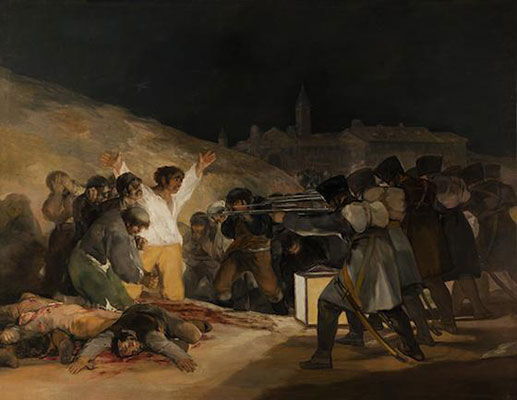
The Third of May, 1808
Napoleon's armies invaded Spain in 1808, bringing an end to Charles IV's reign (and the Enlightenment Era in Spain) and signaling the start of the Peninsular War. Goya painted The Third of May, 1808 and its companion piece, The Second of May, 1808 for the Spanish government, which commissioned the works to celebrate the expulsion of the French army in 1814. The stated purpose of the pictures was to "perpetuate by means of his brush the most notable and heroic actions of our glorious insurrection against the Tyrant of Europe."
Here we see French soldiers executing unarmed Spaniards in retaliation for their rebellion the day before. The focal point of the composition is the unarmed man in the brightly lit center, standing with his arms raised in surrender. The dead bodies of just-executed rebels lie at his feet, while a group of soon-to-be shot rebels stand behind him. The executioners, whose faces Goya obscures, stand shoulder-to-shoulder with their bayonets pointed at the Spanish hero. The anonymity of the French firing squad contrasts with the individualized faces of the victims, and drives home the message of brutal oppression. The painting is considered to be one of the first truly modern images of war, and influenced future works by both Édouard Manet (Execution of Emperor Maximilian) and Pablo Picasso (Massacre in Korea).
Oil on canvas - Museo del Prado, Madrid

Witches' Sabbath
Goya spent his later life largely as a recluse - a lonely, deaf old man completely disillusioned by society. His house outside Madrid, dubbed La Quinta del Sordo, is where he completed his fourteen Black Paintings, applied in oils directly onto the house's plaster walls. Little is known about Goya's intention or thoughts in creating these pictures; he did not write about them in letters, nor did he provide titles for the works. They were intensely private creations, and have come to be seen by art historians as reflections of his declining physical and mental health. They are the expressions of Goya's deepest fears and darkest depression, and are troubling in both their nightmarish content and raw form.
Witches' Sabbath, also referred to as The Great He-Goat, shows the devil in the form of a goat preaching to a group of women, presumably a coven of witches. The devil figure is only seen as a dark silhouette, creating a sense of mystery around the figure. The brushwork, which is much rougher and clumsier than in Goya's earlier works, enhances the raw and even abject quality of the picture, with its huddled cluster of ghastly characters. However, Goya employed the same theatrical contrasts of light and dark as seen in The Third of May, 1808, which here serves only to highlight the repulsive faces of the women. A large portion of the right side of the composition was lost in the transfer from plaster to canvas, and the full meaning and content of the work remains a mystery.
The piece is widely considered to be a criticism of the Inquisition's campaign of intimidation and persecution, which gained renewed force after the restoration of the Bourbon monarchy in 1814 and the ascension of the anti-Enlightenment king, Ferdinand VII. Goya believed wholeheartedly in the principles of the Enlightenment, which privileged reason above religious or cult superstition, and reviled the politically motivated, oppressive practices of the Inquisition.
Oil on plaster, transferred to canvas - Museo del Prado, Madrid
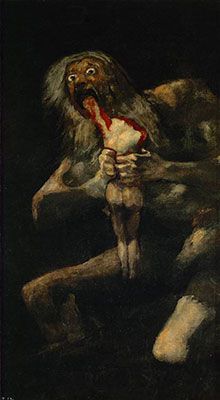
Saturn Devouring His Son
Saturn Devouring His Son is another of Goya's "Black Paintings" produced at La Quinta del Sordo. It depicts the Greek myth of Titan Kronus, who ate his sons because he believed he would be overthrown by one of them (Saturn is the Romanized version of Titan). With his small head and bulging eyes, Saturn opens wide his mouth to gnaw on the arm of his son. The corpse's mutilated body (with red blood streaming from his wounds that is almost shockingly vivid amidst the bleak, subterranean palette) recalls similar figures in The Disasters of War. The work is yet another example of Goya's interest in dark and horrific themes, whether documentary or mythical.
The painting has a similar palette to The Third of May, 1808; dark, rich colors set the overall tone, while light draws our attention to the center of the dramatic action. Goya employed flat, broad brushstrokes and thick impasto throughout the composition; the paint appears to have been quickly applied, almost as if in a frenzied or fevered state.
Although some believe the work was inspired by Peter Paul Rubens' painting of the same theme, art historians such as Fred Licht have expressed doubts regarding Goya's true subject. For instance, Saturn is said to have eaten his sons as infants, yet the victim in Goya's painting appears to be an adult. Likewise, the figure's curvaceous hips and legs call into question its gender (could it be a woman?).
One significant aspect of the picture to note is the association between Saturn and "saturnine" temperaments, or melancholy, an important connection given what is known about Goya's disturbed state of mind when he painted these works. At the very least, the painting expresses the deepest, darkest aspects of his psyche, perhaps expressing the artist's own fears of losing his powers in the face of his declining physical and mental health. On a broader political level, the work can be seen within the context of Goya's time as an allegory of reactionary rule. Certainly the oppressive reign of Ferdinand VII signified a refusal to adapt to the evolution of modern life and society, while the persecutions of the Inquisition cannibalized Spain's very soul. However, because Goya did not write about these works and never intended for them to be displayed in public, his true intentions remain a mystery.
Oil on plaster wall, transferred to canvas - Museo del Prado, Madrid
Biography of Francisco Goya
Childhood
Francisco de Goya y Lucientes was born in Fuendetodos, Spain, to a lower-middle-class family. The fourth of six children, he spent the majority of his childhood in Zaragoza, a nearby city where his family was originally from. He attended a local public school, where he met his lifelong friend Martin Zapater; their letters provide one of the few direct sources of information about Goya's early years in Madrid.
At age 14, he began his artistic studies under painter Jose Luzan, which lasted for four years. He later moved to Madrid to study under Anton Raphael Mengs, a German artist who worked as court painter for the Spanish royal family. Goya's time with Mengs was largely unsuccessful (it is thought that the two men did not get along well), and his submissions to the Real Academia de Bellas Artes de San Fernando were rejected in both 1763 and 1766.
Early Period
Goya's career first took shape after his relocation to Italy around 1770, though details about his activities there are murky. In 1771 he won second place in a painting competition held in Parma with his Sacrifice to Pan. He returned that year to Saragossa, where he began his studies under Francisco Bayeu, who became a close friend. Goya married Bayeu's sister, Josefa, with whom he had several children, though only one son, Javier, survived to adulthood. Goya once said that his son was so beautiful, people on the street in Madrid would stop to look at him, and he was an intensely proud father. When his son fell ill, Goya wrote that he "stopped living for that whole period."
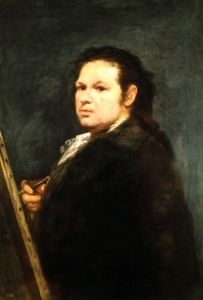
Around 1774, Goya was commissioned to produce a series of cartoons for the Royal Tapestry factory at Santa Barbara. These paintings depict scenes from contemporary Spanish life in a lighthearted and light-toned Rococo manner; the resulting tapestries were installed in two royal palaces. Goya leveraged this experience to grow his connections within the Spanish court. At the same time he also began to work on a set of etchings after paintings by Velázquez in the royal collection. Goya would become a master of printmaking, which came to serve as the primary means by which he expressed his most personal feelings about the social and political events of his day.
Mature Period
Goya began his career as court painter in 1786, under Charles III. Later, he established himself as a favorite of Charles IV, becoming First Court Painter to the king in 1799, the highest position for an artist in the royal household. He would serve in this capacity until the Napoleonic invasion of 1808, though he continued to gain commissions from the new regime after pledging his allegiance to the Bonapartists.
During the height of his affiliation with the Spanish court, Goya befriended the influential Prime Minister Manuel de Godoy, who commissioned other works from the artist for his private collection, including the notorious Nude Maja (c. 1797-1800). This painting led to widespread speculation about the sitter's true identity, sparking rumors of Godoy's illicit affairs with two separate women and his eventual questioning by the Spanish Inquisition.
Goya's burgeoning career was briefly interrupted in 1792 when an undiagnosed illness left him permanently deaf. Although he continued to work for the Spanish royal family, his handicap led him to distance himself from public life as he grew increasingly embittered and melancholy. It was around this time that Goya began working on Los Caprichos, a series of 80 etchings with aquatint that was published in 1799. The prints present an indictment of many aspects of contemporary Spain.
Napoleon's invasion of Spain in 1808 and the subsequent Peninsular War (lasting until 1814) gave Goya ample opportunity to observe and critique society. The war inspired his paintings The Second of May 1808 and The Third of May 1808, as well as his portfolio of etchings titled The Disasters of War. In the words of author Evan S. Connell, these works represent "the prodigious flowering of rage" that Goya felt in the face of so much violence and horror.
Later Period
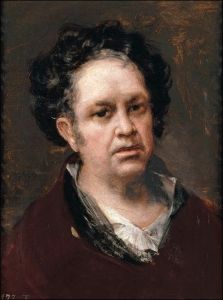
Following the restoration of the Bourbon monarchy in 1814, Goya withdrew completely from public life; little is known about his later years. He moved to a farmhouse on the outskirts of Madrid, La Quinta del Sordo (The House of the Deaf Man), where by 1821 he completed 14 so-called Black Paintings, which were painted directly onto the house's plaster walls. Goya moved to Bordeaux in 1824 to escape the oppressive and autocratic regime of Ferdinand VII. The artist spent the rest of his life in exile in France with his maid and companion, Leocadia Weiss (his wife Josefa had died in 1812), and her daughter until his death in 1828.
The Legacy of Francisco Goya
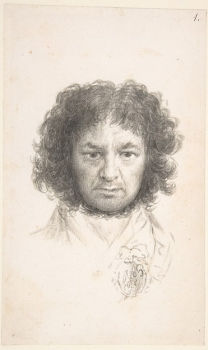
Goya's oeuvre represents a unique marriage of tradition and modernity. As an Old Master, he honored the works of his predecessors like Velázquez and Rembrandt, working in a traditional manner as seen in his many court portraits. At the same time, his bold departure from the artistic conventions of his day earns him a place as one of the first Modern Western painters. For instance, his use of social satire finds its legacy in the works of James Ensor, who likewise pilloried the duped masses and corrupt leaders of his day, while the qualities of shock and horror - seen in his more dark or violent works - find a thread in contemporary art's concern for the abject and psychologically disturbed, from Damien Hirst to Paul McCarthy.
Goya's use of broad, visible brushstrokes paved the way for Impressionism's spontaneous style, as did the quintessentially Spanish subject matter of his art. Édouard Manet's Olympia was influenced by Goya's Nude Maja, and was equally bold, if not bolder, in its radical reinvention of the classical nude as a modern-day prostitute. Meanwhile his fragmentary painting of The Execution of Emperor Maximilian, directly references Goya's The Third of May, 1808 in both its expression of moral outrage and its formal composition, though Manet's sympathies lay on the side of the Mexican executioners, not the murdered Emperor.
Goya's politically engaged, highly subjective, and imaginative art presented a significant step towards modernism. In his prints especially, Goya critiqued the events of his day including war, corruption, social ills, and ingrained superstitions. This would later inspire artists like his fellow Spaniard Picasso, whose seminal Guernica also raged against contemporary injustices, in this case the Fascist bombing of a Spanish village in WWII.
Goya's far-reaching legacy extends to Surrealism, as artists looked to Goya's etchings and Black Paintings for their dark and dreamlike subject matter. Salvador Dalí created his own version of the Caprichos in 1973, and more recently, in 2014, the contemporary artist Emily Lombardo did likewise, reimagining the Caprichos in the framework of 21st-century life. Both Dalí's Surrealist interpretation and Lombardo's queer feminist one signal the enduring, universal, and ultimately malleable significance of Goya's prints. The British twins Jake and Dinos Chapman also looked to Goya for inspiration, most notably in their disturbingly grotesque sculptures derived from The Disasters of War.
Influences and Connections

- Manuel de Godoy
- Sebastian Martinez y Perez
- Juan Valdes Melendez
- Leandro Fernandez de Moratin
Useful Resources on Francisco Goya
- Goya: The Origins of the Modern Temper in ArtOur PickBy Fred Licht
- GoyaBy Robert Hughes
- Goya in The Twilight Of EnlightenmentBy Janis Tomlinson
- Francisco de GoyaBy Martin Schwander
- Goya: His Life & Works in 500 Images: An illustrated account of the artist, his life and context, with a gallery of 300 paintings and drawingsOur PickBy Susie Hodge
- Goya’s Graphic ImaginationOur PickBy Mark McDonald
- Francisco Goya: Life and TimesBy Evan Connell
- Goya: A Portrait of the ArtistOur PickBy Janis Tomlinson
- Old Man GoyaBy Julia Blackburn
- Goya: Order & DisorderOur PickBy Stephanie Stepanek, Frederick Ilchman, Janis Tomlinson, Clifford Ackley, and Jane Braun
- Goya (Basic Art Series 2.0)Our PickBy Rainer & Rose-Marie Hagen
- Goya DrawingsOur PickBy José Manuel Matilla and Manuela Mena
- Francisco Goya: 103 Drawings and EtchingsBy Narim Bender
- Delphi Complete Paintings of Francisco de Goya (Illustrated)Our PickBy Peter Russell
- Francisco Goya - His Complete Etchings, Aquatints and LithographsBy Enrique Lafuente Ferrari
- Goya's Last WorksBy Susan Grace Galassi and Jonathan Brown
- Goya: The PortraitsBy Xavier Bray
